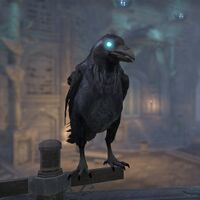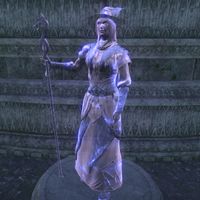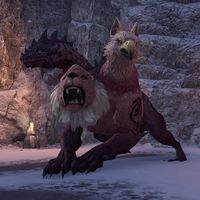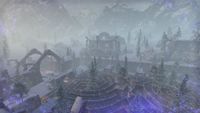Lore:The Crow
| The Crow | |||
|---|---|---|---|
 The Crow The Crow
|
|||
| Race | Luminary | Gender | Female |
| Resided in | Eyevea Wing of the Crow |
||
| Appears in | ESO | ||
The Crow, also known more specifically as the Luminary Crow, was one of the Luminaries of Magic, mysterious immortal beings of pure magic, spirits likened to beams of sunlight from Magnus himself,[1][2] her chosen form was that of a Crow.[2] The Crow was the youngest of the Luminaries by far,[1] she played an important role in the rediscovery of Ulfsild's creation, Scribing, a "metamagical theoryset"[3] which was the precursor to the modern Spellcrafting system.[1][UOL 1]
Unlike the other Luminaries, the Crow was an intentional creation of Archmage Ulfsild the Evergreen, who, partly inspired by The Gryphon's beliefs regarding his own origins,[4] used part of her own soul in a ritual that combined her spirit and a copy of her mind from that moment in time, flashing them upon the great wellspring of arcane power she'd gathered in the Scholarium's Scribing Altar, to create a new Luminary of Magic, a ritual described as the ultimate act of Scribing. As the looming threat of the loss of Eyevea left little time to plan the ritual to Ulfsild's normally exacting standards, the process was not fully refined, causing the Crow to have a chaotic arcane presence. The ritual to create the Crow took an enormous toll upon Ulfsild's spirit, siphoning a considerable amount of her soul. However, though it took years, her spirit eventually recovered.[1][5][6] The Crow described itself as Ulfsild's familiar.[1]
The Crow viewed herself as the piece of Ulfsild left behind to ensure that Scribing would pass to Ulfsild's inheritor and to the world. She described herself as a being born in sorrow but filled with hope, the shadow of a single person, who'd soared on the winds of magic for centuries to ensure Scribing did not become lost to the world. The Crow believed that life was akin to a great maze, and that legacies were a blessing, and thought that the burdens of both should not be endured alone. She viewed the continuation of Ulfsild's work, the Luminaries being safe and happy, and the Scholarium becoming filled with life and laughter once more, as the destiny she was made to realize, and desired to see the world Ulfsild remembered after it was achieved. After spending centuries in the shape of a crow, she preferred her feathers to her previous form.[1]
As with all Luminaries, The Crow was said to possess a mastery of magic that made the average archmage look like a neophyte. As a Luminary, she saw the world and magic in a way that was different from mortals[1][7] As beings of pure magic the Luminaries were said to have understood magic in a way mortals never could and so, their power, freely given, allowed one to access arcane mysteries most could only dream of. Indeed, Scribing is said to have been somehow destined to channel the power of the Luminaries from the start.[1][8]
Contents
History[edit]
Creation[edit]
At some point after 1E 2250, [7][9][10] the Scholarium was lost along with Eyevea, which it was located under, transported to the Shivering Isles due to a bargain Shalidor made with the Daedric Prince Sheogorath in exchange for the Folium Discognitum.[1][11]
Knowing that nothing she or the Luminaries could do would outpace the greed of a Daedric Prince, Ulfsild first froze the Luminary Gryphon in a tempest of ice, the magic of which she tied to a ward she left behind. This prevented the enraged Luminary from confronting Sheogorath, a being against whom even he was no match, while also preventing the Prince from discovering the Scholarium and Luminaries, which would've been disastrous.[12][13][14][1][15][16]
Ulfsild than used what time she had to enact a final plan meant to assure that Scribing would not become lost to the world. She used part of her own soul in a ritual that combined her spirit and a copy of her mind from that moment in time, flashing them upon the great wellspring of arcane power she'd gathered in the Scholarium's Scribing Altar, to create a new Luminary of Magic through a ritual described as the ultimate act of Scribing.[1][5][6] Thus the LumInary Crow was born. With her birth she chose the shape of her physical form, and her personal realm, the Wing of the Crow was also shaped and hewn into existence in the same manner, and became connected to the Scholarium via its own door.[17][8][1]
Before Sheogorath pulled the island out of Nirn, Ulfsild in an effort to preserve her life's work recorded the secrets on how to scribe within the library of the Scholarium.[18] In the event that the Scholarium were to be recovered, she left whoever would don the role as her successor, and emphasized they seek out the Luminaries that would continue guarding the place.[19]
With the doors closed, the altar became dormant. Without that beating heart, the mastery of Scribing was believed to stagnate.[1] The Scholarium itself was not discovered, however, for it had been warded against mages, Princes, and powers, long ago, and those defenses held strong even in the Shivering Isles. The Crow did not have much time to speak with Ulfsild, her other self, before the doors were sealed.[1]
Ulfsild left numerous messages for potential future inheritors of the lost art of Scribing, and creating Echoes. They were magical projections of herself with messages for future spell creators within the Scholarium and Sunnamere. These instructional illusions, scattered throughout the library, were meant to guide the inheritor through the process of contacting the Luminaries.[1] Among the known visages of her were the Flickering Image, and Ulfsild's Echoes of Introduction, the Lens, Regret, the Dragon, Loyalty, Mystery, Charity, the Final Trial, and of the Netch.[20]
Rediscovery of Scribing[edit]
In 2E 582, either before or after Eyevea was returned to Tamriel by Shalidor and the Mages Guild, the Scholarium was rediscovered by a group of knights from the Order of the Lamp. During their arrival, complications arose, necessitating the sealing of the doors to prevent a catastrophe, as the once dormant altar became unstable, threatening the lives of everyone present. The disaster was prevented due to the intervention of the Vestige, who replaced the unstable focusing crystal. This potentially also prevented the discovery of the Scholarium by Sheogorath, an event which would've been catastrophic.[1][21]
After the magic was calmed, the Scholarium's caretaker, the Luminary Crow, directed the Vestige to seek out the other Luminaries and gain their support in order to return their strength to the altar. An act equated to inheriting Ulfsild's legacy and leaving a mark on spellcraft itself.[1]
The Inheritor of the Scholarium retraced Ulfsild's footsteps, guided by her echoes and the True Sight Lens she'd left behind to allow them to see magicka and Ley Lines with their eyes, as she could, discovering the fable and keys, breaking the wards, and entering the Wings of the Indrik, the Dragon, the Gryphon, and the Netch, to reconnect the Scholarium with them. The Luminaries gave the Inheritor a series of challenges to complete in order to prove themselves as Ulfsild's Inheritor. After their tasks were completed, the Luminaries agreed to lend their power.[2][22][12][8][1]
With their trials completed, the Luminaries granted their Sigils to the Inheritor. Placed at the altar, the Sigils restored the connection between the realms of the Luminaries and the Scholarium, and their strength flowed into the altar once more.[2][23][24][13][25] With their strength fueling it, the altar could once more achieve incredible feats of magic, allowing it to "shape the very heart of magic itself" and translate its very essence into mortal hands with the Luminary as the intermediary, thereby changing, or rewriting, both the magic and the mortal, as the practicioner scrawled their soul upon the page.[1][8] This reconnection led to the great power of the Luminaries causing new Ley Line activity across Tamriel, thus making Affix Scripts, Signature Scripts and Luminous Ink appear across the land[8][26][27][28][29]
With the support of the other Luminaries now assured, the Crow revealed the truth. She was the final Luminary, created by Ulfsild herself, and the last who could lend her power to the Scribing Altar. The chaotic magic that had originally led to the rediscovery of the Scholarium was a result of the Crow's own presence, as Ulfsild's ritual had never been fully refined due to the urgency of the situation not allowing enough time for it.[1]
In the Wing of the Crow the Vestige underwent the final trial to be declared the inheritor of Ulfsild's legacy. Within the Luminary Crow's replica of Labyrinthian. the Inheritor bested the Chimera Aut'arioth, which the Crow had summoned to serve as the final challenge. The Dragon and the other Luminaries than appeared, and acknowledged the Vestige as the inheritor of Ulfsild's legacy. With the final test completed, the Crow guided the Inheritor to retrieve her own Sigil, which Ulfsild had taken with her when she departed, so it too could be added to the Scribing Altar, amplifying its power further.[2][17] Knowing the Inheritor had other adventures calling to them, the Crow chose Order of the Lamp Votary Nahlia to act as the Scholarium's new caretaker. Thus Scribing returned to Tamriel.[1][21]
Vanus Galerion was particularly enthusiastic of the possibilities it would open up, with early ideas being altars being installed in every guild hall, or that Scribing will perhaps one day be taught in the wilds.[7] The legacy of Ulfsild's lived on, with Scribing eventually evolving into the modern Spellcrafting systems.[UOL 1]
Fable of the Crow[edit]
The Fable of the Crow is a story recounting the events that led to the birth of the Luminary Crow. In the tale, the Crow met with the Raven who, wise and solitary from his many years, was the only one who could match her wits. The two built a grand nest and all the magic of the forest was theirs.[5]
The Crow filled the nest with shiny gifts from her friends in the woods. Though she explained the gifts were meant to protect her and strengthen their friendship and were given in compassion, the Raven was skeptical, as he viewed them as "an awful lot of unexpected charity". The Raven soon lost interest in the gifts, but complained no further, as he saw they made the Crow happy.[5]
One day the Raven returned, eyes glittering with a longing never before seen in him. He explained that he'd met a Stranger who'd promised he'd give him a star in exchange for the nest. The Raven spoke of what wondrous things he could do with the star in his hands. The Crow was distraught, and wondered if something had changed in the Raven, or if he'd always been this way. The Raven set his deal in motion, and there was no going back.[5]
Realizing he'd done wrong, the Raven offered to help move what he could from her cache in the nest to safety before the Stranger took it. But the Crow refused. If the things in her cache were incomplete or, worse, if the Stranger found them, it would spell disaster.[5]
Thus the Crow decided to leave the nest behind under secret guard. She plucked her own dark feathers, enough to practically make another Crow and, without realizing she'd done it, Feather-Crow was born. A being made in her image, not unlike her friends of the forest. Crow told Feather-Crow to hide among the leaves and gifts and guard the nest. Crow's own feathers would one day grow back, and she'd build a new nest. Than her fledglings would come to reclaim the nest, fed on stories they'd see the dark leaves and recognize their mother's feathers.[5]
But Feather-Crow had come from Crow. And so knew that, for all the talk of adding others, the new nest would remain barren. Thus Feather-Crow made its vow. The new fledglings could come from wherever and, so long as they embodied the virtues of her friends in the forest, their gifts and magic would be shared with them in turn.[5]
Wing of the Crow[edit]
The Wing of the Crow is a pocket realm belonging to the Luminary Crow. It was shaped and hewn into being in the same way she chose her form. The reason for the realm's formation was unknown, though the Luminary Indrik theorized that the realms of the Luminaries had formed due to the wisdom of Aetherius, which did not wish for the Luminaries to be both alone and wandering.
The realm resembles a copy of Shalidor's ancient maze, Labyrinthian, it was shaped by the Crow to be the perfect trial space. As with the realms of all Luminaries, it had a warded door and a key which one had to use to enter it.
See Also[edit]
- For game-specific information, see the Elder Scrolls Online
 article.
article.
References[edit]
- ^ a b c d e f g h i j k l m n o p q r s t u The Crow's dialogue in ESO
- ^ a b c d e The Dragon's dialogue in ESO
- ^ The Largesse of the Archmagister in ESO
- ^ Ulfsild's Notes: The Origin of Luminaries — Ulfsild
- ^ a b c d e f g h Fable of the Crow
- ^ a b Ulfsild the Evergreen's dialogue in ESO
- ^ a b c Loremaster's Archive - Scribing — Votary Nahila
- ^ a b c d e The Indrik's dialogue in ESO: Gold Road
- ^ Mages Guild Charter
- ^ Ulfsild's Log: The Indrik — Ulfsild
- ^ Arch-Mage Shalidor's dialogue in ESO
- ^ a b The Gryphon's dialogue in ESO
- ^ a b The Wing of the Gryphon quest in ESO: Gold Road
- ^ The Fox's dialogue in ESO
- ^ Ulfisild's Echo of Regret's dialogue in ESO
- ^ Ulfisild's Echo of Loyalty's dialogue in ESO
- ^ a b The Wing of the Crow quest in ESO: Gold Road
- ^ How to Scribe — Ulfsild
- ^ Ulfsild's Log: Your Discovery, My Farewell — Ulfsild
- ^ Flickering Image, Ulfsild's Echo of Introduction, Ulfsild's Echo of the Lens, Ulfsild's Echo of Regret, Ulfsild's Echo of the Dragon, Ulfsild's Echo of Loyalty, Ulfsild's Echo of Mystery, Ulfsild's Echo of Charity, Ulfsild's Echo of the Final Trial, and Ulfsild's Echo of the Netch's dialogue in ESO
- ^ a b The Second Era of Scribing quest in ESO: Gold Road
- ^ The Netch's dialogue in ESO
- ^ The Wing of the Dragon quest in ESO: Gold Road
- ^ The Wing of the Indrik quest in ESO: Gold Road
- ^ The Wing of the Netch quest in ESO: Gold Road
- ^ Sigil of the Dragon Analysis in ESO
- ^ Sigil of the Indrik Analysis in ESO
- ^ Sigil of the Gryphon Analysis in ESO
- ^ Sigil of the Netch Analysis in ESO
Note: The following references are considered to be unofficial sources. They are included to round off this article and may not be authoritative or conclusive.
| |||||||||||






